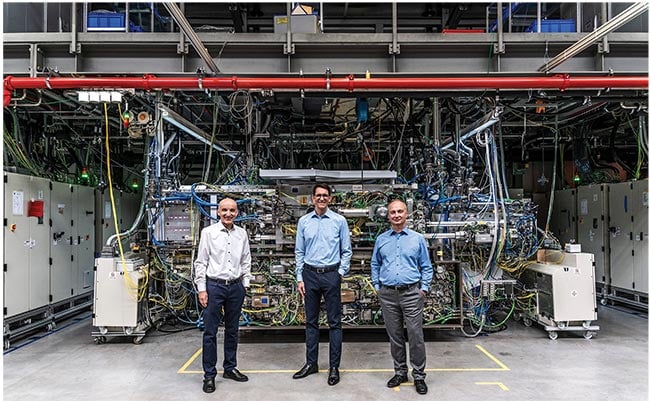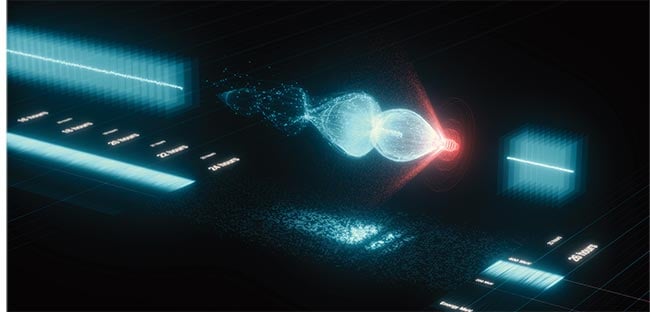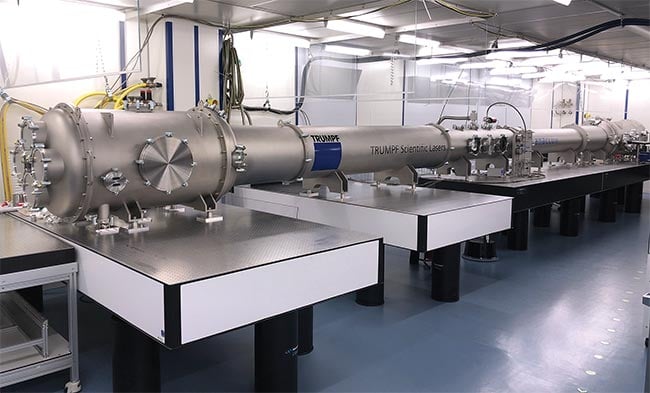Advancements in ultrashort-pulse laser technology are enabling substantial progress in the field of secondary sources. The application areas that are poised to benefit range from science to biomedical and laser fusion.
ANDREAS THOSS, CONTRIBUTING EDITOR
For many years, secondary sources were just a vision held by scientists. Eventually, their progress was driven by the goal to build a particle accelerator, such as the Large Hadron Collider in a laser lab at the European Council for Nuclear Research (CERN).
The physics behind this vision are intriguing: An electron can be accelerated by a light pulse much faster, and much more energy efficient, than by an electromagnetic pulse in a regular particle accelerator.
An urgent need from big business — namely, the semiconductor industry — led to the first industrial-scale solution. The semiconductor industry required a source of extreme-ultraviolet (EUV) radiation with a wavelength of 13.5 nm to meet
its manufacturing demands. It took the brilliant ideas of some scientists, plus
the bravery of a few business leaders, to
develop a secondary source for this
purpose. ASML’s latest generation of lithography machines is based on this
device, which includes the largest laser ever built in serial manufacturing. This was a surprise for many laser experts,
because the actual laser inside the system is not a new solid-state laser but the almost-forgotten CO2 laser (Figure 1).

Figure 1. A laser-based secondary source for extreme-ultraviolet (EUV) radiation during the manufacture of the laser system. The system contains a seed laser and a three-stage amplifier
based on CO2 technology. Representatives of TRUMPF, ZEISS, and Fraunhofer IOF won the Deutscher Zukunftspreis 2020 (German Future Prize, presented by the Federal President) for the EUV
lithography project. Courtesy of TRUMPF Group.
Chips made with these machines are a must-have in the consumer electronics sector; simply, companies run the risk of being left behind without access to the technology. Industry giant Intel, for
example, recently adopted the next
generation of EUV lithography machines.
Currently, this secondary source generates approximately $1 billion in annual revenue for its manufacturer, TRUMPF. The formula that describes this technology is simple: one manufacturer, one customer, one big success. The price of ASML stock has increased ~40× since it began promoting EUV nearly 15 years ago in 2010.
The question of whether secondary sources can do more is easily answered: Yes. But answering this question more profoundly requires some background information.
What are secondary sources?
Most often, secondary sources refer to sources of x-ray, electron, or particle beams that are based on lasers as the primary beam source. Secondary sources offer the potential to replace conventional, large particle accelerators with much smaller, laser-based systems. Although laser-based secondary sources are the focus of this article, electron or proton beams can also be used as a driving
beam.
Since electrons can be accelerated over a shorter distance with light waves than with microwaves, which have historically been used for accelerator schemes,
laser-driven secondary sources hold obvious benefits. These laser accelerators
are considerably smaller and require significantly less electrical energy. They promise new opportunities in medicine, particle physics, and other disciplines
that require accelerated particles or the resulting radiation. This includes industrial process optimization — for example, melt pool videography of copper welding processes for e-mobility1.
What are the challenges?
Laser-based particle acceleration is not a new field of research, though the advent of laser sources with extremely high peak powers and progress in plasma physics has led to substantial progress in recent years. These factors, paired with the
obvious driver — a heightened need from industry — intensified focus and furthered innovation in this technology
area.
One system in particular exemplifies
many of the challenges that have been overcome with regard to secondary
sources. The EUV source that the TRUMPF Group sells to ASML shines a 30-kW CO2 laser onto tiny droplets of
tin that emit EUV (or soft x-rays) at
13.5 nm. This laser is the biggest in serial production. Stability, debris mitigation — all tin droplets are vaporized in a
vacuum — plus power scaling and conversion efficiency were among the issues that the developers addressed in this solution2.
The TRUMPF-built system is obviously one of the most complex laser sources in the world. Yet, it is still a rather simple secondary source. The amplified laser pulse hits a target, and the energy of the main pulse (a pre-pulse shapes the target for increased conversion efficiency) is converted into EUV radiation. This radiation is collected with a huge mirror and sent to the lithography scanner.
Lasers can be used for many more conversion effects, either to generate energetic photons or to accelerate particles. Energetic photons can be generated through nonlinear effects such as high-harmonic generation (HHG). This process demonstrated its utility by enabling the generation of attosecond pulses, for which three acclaimed scientists earned the 2023 Nobel Prize in Physics.
Other processes generate x-rays, too. Inverse Compton scattering, where a
low-energy photon scatters with an
electron, is one additional example.
Further, accelerated electrons hitting a target may create x-rays in a process that is similar to what happens in any x-ray tube.
The laser-based acceleration of electrons is a fascinating aspect of plasma physics: When a laser pulse passes through a plasma, it is a moving electromagnetic field. The field exerts a force on the electrons, pushing them from places with high electric fields to places where the field intensity is low. The light pulse moves through the plasma, as does the electron density wave that it creates. The electrons “surf” on this wave at the speed of light in this medium (Figure 2). This process, laser wakefield acceleration, can accelerate electrons to giga-electronvolts within a few centimeters of the plasma. Such fast electrons can be used to drive protons or other ions. Fast protons can even create neutron beams.

Figure 2. In laser-plasma acceleration, a strong laser pulse (red) generates a plasma wave (blue) in hydrogen gas by stripping electrons from gas molecules. The electrons “ride” this wave to high energies at extremely high rates of speed.
Courtesy of DESY.
This plasma-physical approach may explain why secondary sources are considered candidates to replace a stage in a particle accelerator, such as those at CERN or SLAC: A laser could accelerate electron bunches to mega-electronvolt or giga-electronvolt energies in comparatively short stages. Such a tabletop setup could replace hundreds of meters of acceleration line and consume ~10× less energy.
While this approach is tempting, it comes with its own challenges. For example, the electron bunch, under this approach, would require beam parameters corresponding to those of the subsequent conventional stages. This interfacing itself poses a challenge. Still, scientists working on the PETRA project at Deutsches Elektronen-Synchrotron (DESY), in Hamburg, Germany, have put the development of such a device on their agenda for the next generation of electron synchrotrons. There, the electron bunches from PETRA are used to create brilliant x-rays.
What are secondary sources good for?
The increasing interest in secondary sources, as well as the dream to replace particle accelerators, owes to a multitude of possible supported applications. These extend well beyond the generation of EUV radiation — a product that already commands a $1 billion market.
One application is related to brilliant x-rays. The term brilliance refers to a combination of intensity and small focus for these x-ray beams. In 2013, scientists at PETRA created a focus of <5 nm in diameter. These beams could “see” the inner structure of biological and technical samples with extreme precision, thereby offering high value to the medical and engineering communities.
As one might expect, beam time at PETRA is always overbooked. Imagine if engineers could bypass moving all their experimental equipment to an accelerator facility for seven days of beam time. Or, consider a quality control system in battery manufacturing that can see each pore in its welds at micron resolution in real time. The list of applications for brilliant, pulsed x-rays is long and apt to grow with the availability of more and cheaper sources.
Another application benefiting the biomedical sector involves the use of a separate secondary source. Fast electrons can be used to accelerate ions, such as protons. A tabletop proton source would be desirable for cancer treatment. Shooting protons or energetic photons into specialty materials, such as beryllium, for example, can trigger the emission of neutrons. A tabletop, turnkey source of neutrons could be used to view the contents of barrels with nuclear waste without the need to open these potentially hazardous vessels. Scanning shipping containers at port to determine the quantity and quality of contents is another possible use case.
Finally, the development of secondary sources is closely connected to nuclear fusion. The successful experiment at the National Ignition Facility (NIF) in 2022 was executed with a system that turned energetic laser beams into x-rays, which started the fusion reaction in a tiny capsule with deuterium and tritium. Meanwhile, other schemes use accelerated ions to ignite fusion.
New systems for secondary sources
The availability of new ultrashort-pulse laser systems has propelled the development of secondary sources in recent years. The reason traces back to its physics: The acceleration of electrons in a laser plasma scales with the intensity of the laser pulses driving the plasma. The laser intensity is expressed as energy per time (equals peak power) and per focal area. Because the focal area cannot be smaller than the wavelength of the laser, the peak power is the way to scale up laser intensity. This can be achieved with both higher pulse energies and shorter pulse length. Terawatt or petawatt lasers, for
example, refer to measures of peak power(s).
The biggest scientific lasers in the world currently reach intensities of
~10 PW. Such systems require a hall full of amplifier stages and huge vacuum vessels for the pulse compressors. The source at Extreme Light Infrastructure — Nuclear Physics facility (ELI NP) in Magurele, Romania, for example, achieves one shot per minute. Currently, the laser with the highest pulse energy stands in California at NIF, where it is managed by Lawrence Livermore National Laboratory. This system delivers slightly >2 MJ/pulse at a rate of about one shot per day.
Obviously, these systems are intended for basic research. So, what lasers would be applied for industrial secondary sources?
“This depends on the desired application,” said Tom Metzger, CEO of TRUMPF Scientific Lasers, who supplied the data for Table 1. “There is no single system that could serve them all.”

Figure 3. A Herriott cell used to compress a 200-mJ pulse down to 45 fs.
Courtesy of TRUMPF Scientific Lasers.
“But these are no fixed values. Most scientists use laser sources they can get for their experiments,” Metzger said.
Ti:sapphire vs. neodymium-doped glasses
The choice of laser crystal is a core question for the development of a laser system. So far, most lasers for secondary sources have been scientific systems, for which the characteristics of maximum intensity or energy dominate compared to efficiency and/or repetition rate. Titanium:sapphire (Ti:sapphire) is established as an excellent material for these systems. It offers a broad emission spectrum for the amplification of ultrashort (i.e., broadband) pulses.
Unfortunately, Ti:sapphire must be pumped in the green spectral region, which is usually performed with a frequency-doubled neodymium (Nd)-doped laser. During the past several decades, these have moved from lamp-pumped to diode-pumped, and from 10-Hz repetition rate(s) to multiple kilohertz.
For industrial applications, direct-diode pumping is favored to increase the wall-plug efficiency and to reduce unit price. This provides motivation for TRUMPF Scientific Lasers, for example, to develop lasers based on ytterbium-doped crystals. These lasers can be pumped with diode bars at 9xx nm. Their gain bandwidth is comparably smaller. As a result, the spectrum of amplified pulses must be broadened if ultrashort pulses <500 fs are desired. This is typically completed via Herriott cells, which were initially developed to improve the sensitivity of spectroscopic measurements with a multipass gas cell (Figure 3). Herriott cells can also be used to introduce self-phase modulation, which leads to spectral broadening. Of course, the intensity of the laser pulse must be limited to avoid filamentation or optical damage. Thus, the size of the Herriott cell scales with pulse energy and the desired spectral broadening, which is equal to pulse shortening.
Several methods exist for the generation and amplification of ultrashort pulses. The questions of regenerative or multipass amplification, as well as the geometry of the amplification crystal, each play great roles. The developers at TRUMPF Scientific Lasers use a full range of industrial laser systems from the parent company to build modular systems that can drive secondary sources (Table 1). Fiber lasers deliver the best-quality pulses in oscillators. For amplification, developers may choose between disk, slab, and multislab geometries.
The top row of Table 1 describes how TRUMPF Group developers use a variety of geometries of ytterbium-doped crystals for the amplification of short pulses. The lower row shows the achieved pulse
parameters with additional pulse compression schemes.
Table 1.
Portfolio of Technological Building Blocks at TRUMPF
Orders of Magnitude of Pulse Energies, Pulse Powers, and Intensities

Courtesy of TRUMPF Group.
Laser fusion and secondary sources
At the recent International Laser Technology Congress AKL’24, Constantin Haefner, Fraunhofer-Gesellschaft’s newly appointed executive board member responsible for research and transfer and executive director of the Fraunhofer Institute for Laser Technology ILT, presented a closing lecture on the topic of laser inertial confinement fusion as an opportunity for industry. Haefner also heads the expert committee on inertial confinement fusion of the Federal Ministry of Education and Research BMBF, and he offered a forecast based on results from NIF, which uses an indirect drive method. It is the only method so far that has been used to achieve a burning and ignited plasma regime.
For such a future laser driver, Haefner anticipated parameters of laser pulse energy in the range of 3 to 5 MJ UV radiation; average laser power of ~40 MW and peak power at ~500 TW; and wall-plug efficiency in the range of 10% to 20%.
While NIF was built for one shot per day, the new device should enable 10 shots/s. A major non-laser requirement for this regime is a low price for the almost 900,000 target capsules that the system consumes each day.
Table 2.
Typical Laser Source Parameters for Specific Secondary Sources

Courtesy of TRUMPF Group.
Again, these values and figures are based on a method that just started working at NIF. So, any progress with direct drive — as investigated, for example, at the Laboratory for Laser Energetics in Rochester, N.Y. — or the various
approaches pursued by laser fusion startups, could change the game.
Steve Patterson, CTO of Leonardo Electronics US, showed at the AKL congress that the efficiency of high-power diode modules is a key parameter for future fusion systems. Leonardo has supplied such modules to former fusion experiments and is engaged in new developments in Germany and the U.S.
This shows an obvious relation to secondary sources: “All secondary sources will benefit from the fusion developments,” Metzger said.
“Cheaper and more efficient diode modules will be a key enabler for industrial high-power lasers needed for secondary sources,” Metzger said. These lasers will be there long before a fusion power plant goes online. And it is not only about diodes: Beam delivery components, targets, and secondary radiation transport solutions are among the fields poised to benefit from government-supported fusion research. Secondary sources may remain a niche market, but the technological spillover from the development of laser fusion could provide the decisive boost to make these projects economically viable.
For his part, Haefner assumes that several hundred beamline modules are needed for a prospective power station. The development of the technology is already underway. According to a German road map for laser fusion, which Haefner shared at AKL’24, performance scaling of pump diodes is beginning now, with the scaling of pump diode production capacities scheduled to occur in five years.
Meanwhile, a first call, the PriFUSIO initiative, has been issued by BMBF and aims to develop key technologies for climate-neutral fusion power plants. Further developments are anticipated to follow.
References
1. A. Thoss. (2023). The Path to Secondary Sources. Photonics Spectra, Vol. 57, No. 7, pp. 42-47.
2. I. Fomenkov et al. (2017). Light sources
for high-volume manufacturing EUV
lithography: technology, performance, and power scaling. Adv Opt Techn, Vol. 6,
No. 3-4, pp. 173-186.